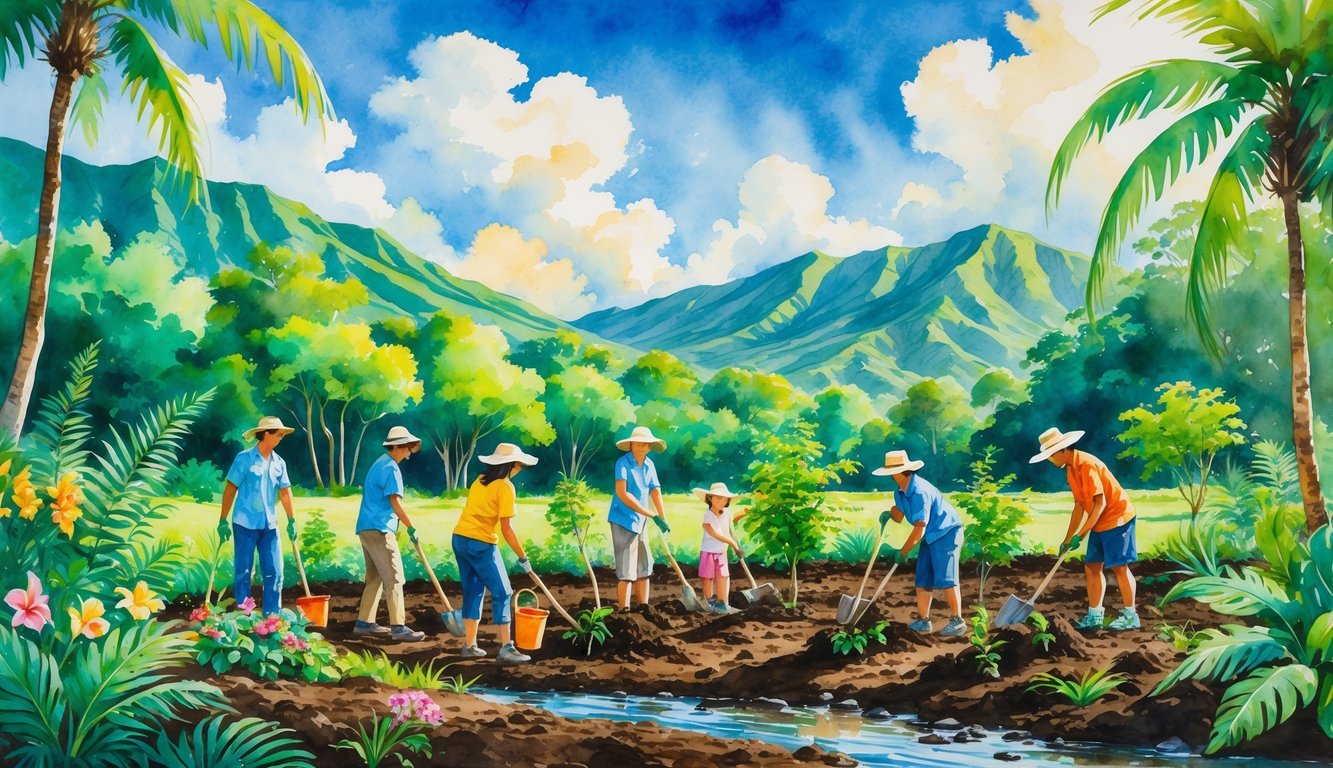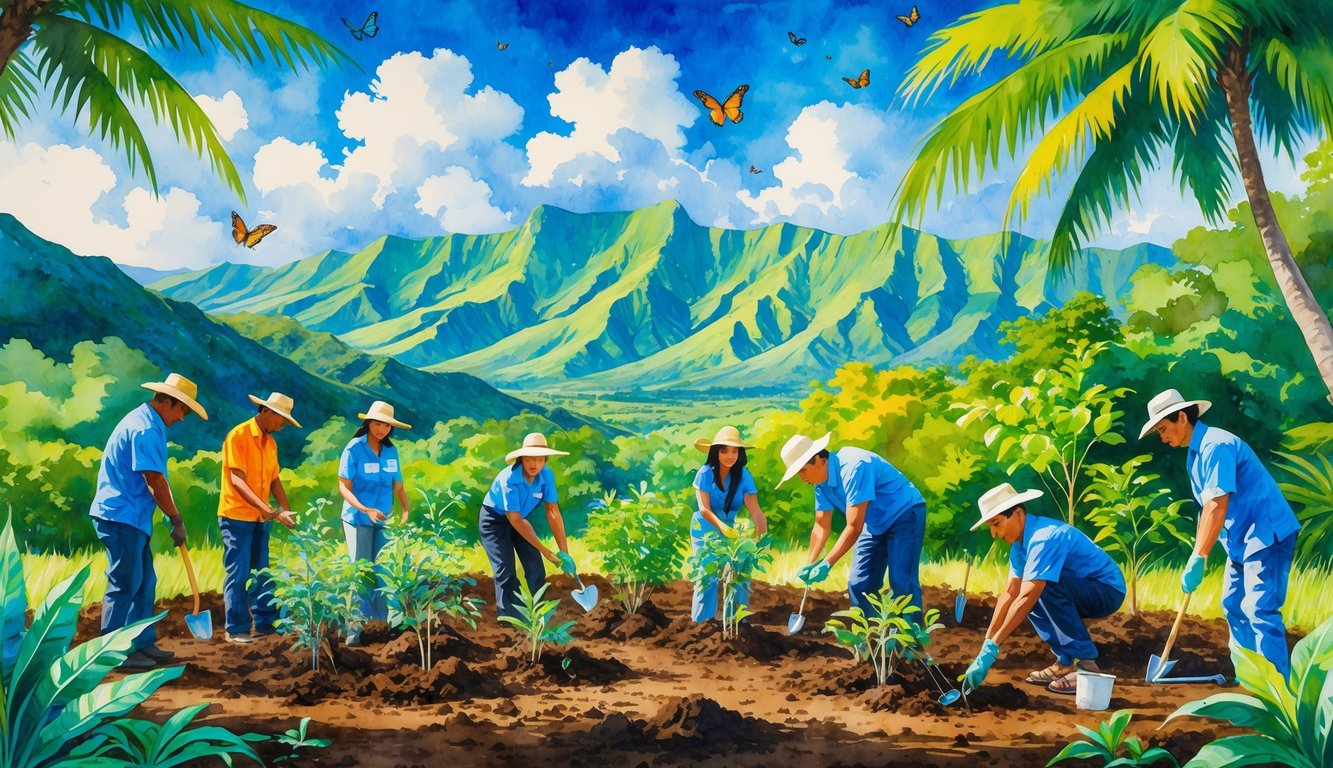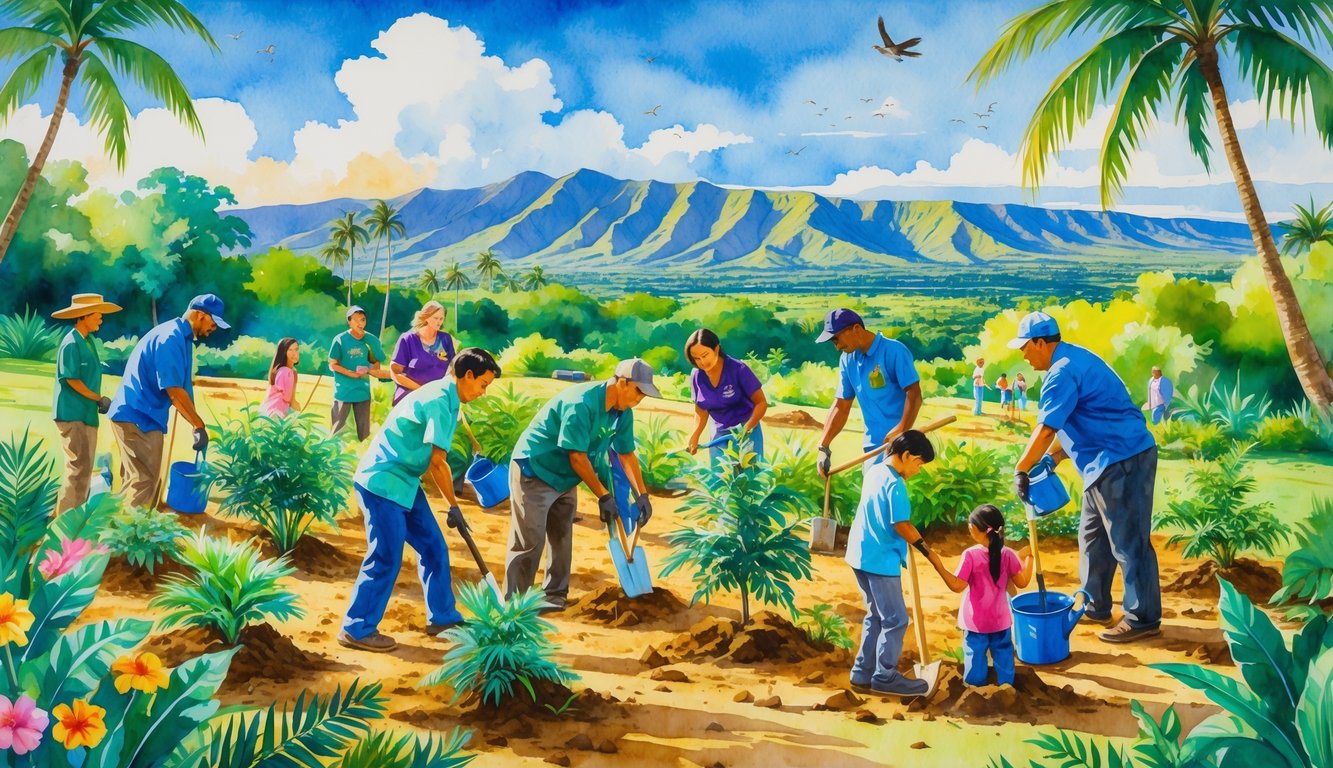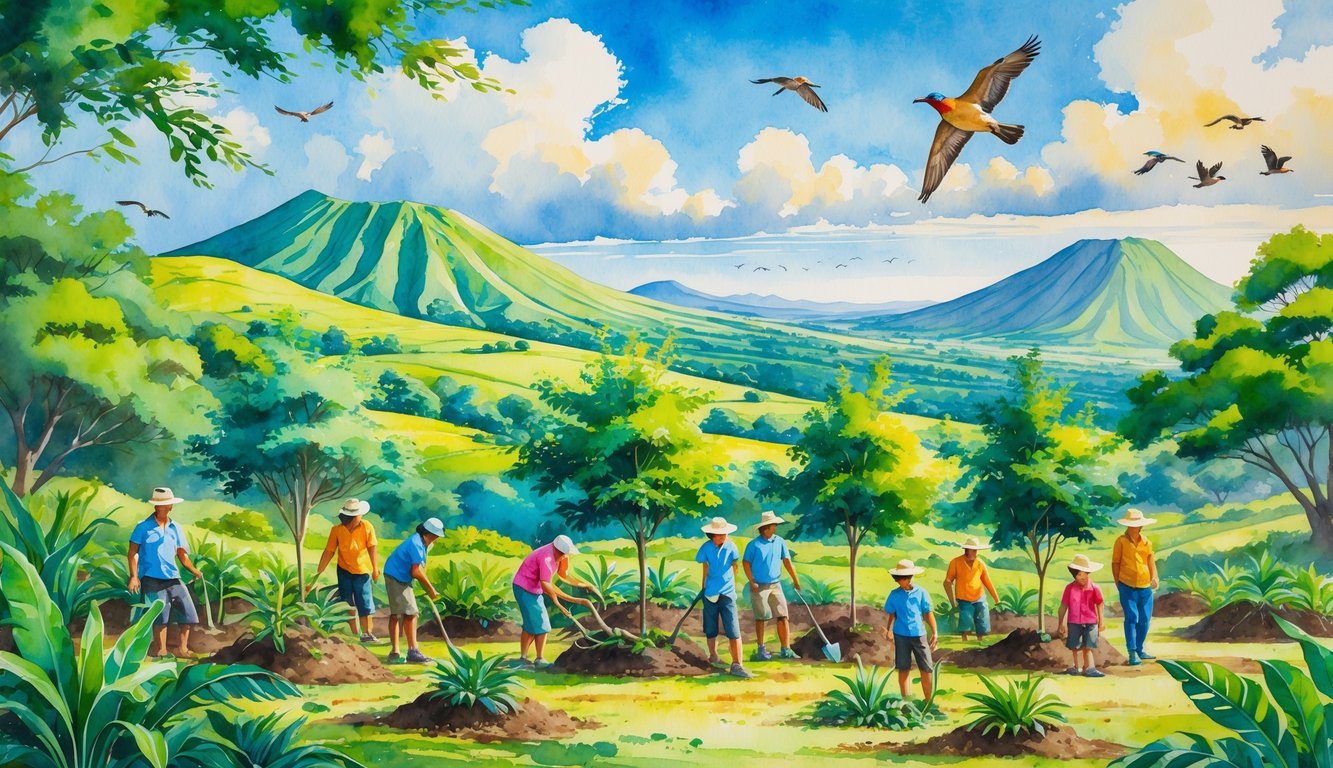When I first learned about Hawaii’s forests, I felt amazed by how much they matter to the land and its people.

Native trees and plants keep the islands beautiful and healthy, but many forests have disappeared or suffered damage over time.
I can make a real difference by joining efforts to plant trees, volunteering, or supporting local reforestation groups in Hawaii.

Reforestation is easier than I thought.
I can join community tree planting days, donate to organizations like the Hawaiian Legacy Reforestation Initiative, or volunteer with local projects.
Every action helps native forests grow strong again.
I wanted to know how to get started, so I found simple ways to participate that anyone—even visitors—can join.
If I want to help Hawaii’s forests thrive, there’s a place for me to pitch in.
Understanding Reforestation in Hawaii
When I support forests in Hawaii, I protect rare plants and help local wildlife.
Reforestation projects focus on saving native trees and improving the environment for future generations.
The Importance of Native Trees
Native trees like koa, iliahi (sandalwood), milo, and kou play a big part in Hawaii’s ecosystem.
When I plant these species, I help bring back habitats for native birds and animals, especially endangered species such as the Palila bird.
Many of these trees hold cultural significance for Native Hawaiians.
Native trees shape the land’s soil and water cycle.
Their roots prevent erosion, and their leaves add nutrients to the soil.
Losing these trees caused problems with soil and water, so planting them makes a real difference today.
Groups like the Hawaiian Legacy Reforestation Initiative focus on these valuable trees to restore healthy native forests.
Environmental Conservation Goals
When I join reforestation, I help repair lost or damaged forests.
Programs in Hawaii protect endangered species by giving them safe places to live.
Many groups plant more koa, iliahi, and other native trees and fence off these areas to keep out invasive animals.
Reforestation also helps the land store more carbon, which fights climate change.
It can recharge watersheds, so the islands have more clean water.
Projects use smart science and careful planning, like those led by the Hawaiian Reforestation Program.
Environmental Challenges Facing Hawaii
Restoring forests in Hawaii is not easy.
Many non-native plants and animals now live in the wild here.
Fast-growing grasses, like bamboo, can take over and block out sunlight from native species.
Before I plant native trees, I need to help with fencing and removing invasive species.
Other challenges include dry climates, wildfire risk, and diseases that hurt native trees such as koa.
Some areas use hybrid reforestation methods, planting both native and non-invasive trees to help stabilize the land.
Overcoming these problems takes teamwork between organizations, local communities, and conservation leaders like OHA (Office of Hawaiian Affairs).
Ways to Participate in Hawaiian Reforestation

I can make a difference by joining local projects, supporting native species, and respecting Hawaiian culture.
There are many hands-on activities, partnerships, and learning opportunities for people who care about the land.
Individual Volunteering Opportunities
I can volunteer by signing up for tree planting days, forest restoration walks, or native seed collection.
Several groups post these chances on their websites or social media.
During these events, I might plant native trees like koa or ohia, remove invasive species, or care for young saplings.
My work can increase native plant coverage and help rare Hawaiian birds and insects.
These volunteer events welcome people of any skill level, and staff give clear guidance and safety tips.
I can join by myself or invite a friend.
A good example is the Plant a Legacy Tree on Hawaiʻi Island experience, where I can plant a native tree and support local reforestation efforts.
Community-Based Projects
When I join larger community-based projects, I work with local residents, organizations, and sometimes schools or businesses.
These projects often focus on restoring whole sections of land.
I’ve seen efforts that mix conservation science and Hawaiian cultural values.
Programs run by groups like the Akaka Foundation for Tropical Forests connect me with long-term stewardship strategies.
Communities teach each other about growing native forests and caring for sacred places.
Common activities include group planting days, community clean-ups, and monitoring reforested areas.
By joining, I support sustainable practices and help build a network of people working for the same purpose.
Educational and Cultural Programs
I can join educational and cultural programs to learn about native forests, Hawaiian culture, and why land care matters.
Many local organizations offer guided walks, workshops, and school field trips that mix lessons on ecology with traditional knowledge.
I discover the stories of the plants and how Hawaiians have cared for the land for centuries.
Some programs use guest speakers, hands-on lessons, or games to make learning fun.
I might get the chance to try activities like lei-making with native plants or learn songs and chants that honor the forest.
Learning this way helps me understand the connection between healthy forests and thriving communities.
Groups such as the Hawaiian Legacy Reforestation Initiative make these learning experiences possible.
Choosing Hawaii Locations for Reforestation

Hawaii offers many special places for reforestation.
Different islands have different native plants and needs, so choosing a location affects how I help restore habitats and protect species.
Oahu
When I think about reforestation on Oahu, I notice its mix of forests and community programs.
Oahu has several state parks and natural reserves where people plant native trees.
Some projects protect important watersheds, which provide drinking water for the island.
Volunteers help with planting trees and caring for native plants.
I can find programs that welcome groups, families, or solo participants.
Popular sites include the Honolulu Watershed Forest Reserve, and areas in the Koolau and Waianae mountain ranges.
These places aim to restore native vegetation and reduce invasive species.
Oahu’s efforts also help endangered birds and protect rare plants.
If I want to join a group or get hands-on in local projects, Oahu is a great place to start with many options for residents and visitors.
Other Key Islands
If I want to explore reforestation off Oahu, I can look at the Big Island, Maui, or Kauai.
The Big Island stands out for its large reforestation efforts, like the Hawaiian Legacy Reforestation Initiative, where I can plant legacy trees.
On Maui, projects work to restore dry forests and protect unique plants.
Fenced reserves keep out invasive animals while native plants and trees get a fresh start.
Volunteering lets me take part in tree planting or habitat restoration.
Kauai has native forest programs in places like Koke‘e State Park and Alakai Swamp.
These projects rebuild forests and improve watersheds.
Many tours and volunteer days are open to me if I want to help.
Each island focuses on restoring different ecosystems, so my work can change depending on location.
By picking a project that matches my interests, I help make a real difference in Hawaii’s forests.
Notable Organizations and Initiatives

When I join a trusted reforestation program, I can make a real difference.
Some organizations in Hawaii focus on planting native trees, improving habitats, and involving visitors and residents in hands-on conservation.
These groups protect endangered species and restore important forest areas.
Hawaiian Legacy Reforestation Initiative
The Hawaiian Legacy Reforestation Initiative (HLRI) is a non-profit that has worked since 2014 to restore native forests in Hawaii.
I can sponsor or plant trees myself on Hawaiʻi Island.
Common native species like koa and sandalwood are a big focus.
These trees clean the air and protect homes for rare plants and animals.
HLRI uses advanced tracking so I can follow the growth of each tree I plant.
They run reforestation projects across lands that were once damaged.
Their programs are educational and hands-on, giving me a chance to learn why native trees matter for Hawaii’s future.
Options for involvement include guided tours, tree planting events, and remote sponsorship.
More details are on the Hawaiian Legacy Reforestation Initiative website.
Partnering with Local Groups
Many local groups in Hawaii welcome help from residents and visitors.
These groups make it easy for me to volunteer, even if I only have a few hours.
Some run regular tree planting days where anyone can join.
Working with these groups teaches me about Hawaiian forest ecosystems.
Volunteers plant trees, collect seeds, remove invasive species, and care for young trees.
Projects are often family-friendly, so I can bring kids or friends.
Partnering with these groups lets me support community-led conservation.
Groups may work with schools, cultural organizations, and local businesses.
Participating helps me see the results of my efforts while supporting Hawaii’s forests.
Opportunities may be shared by community centers, environmental clubs, or initiatives like the Plant A Legacy Tree experience on Hawaiʻi Island.
Best Practices for Sustainable Reforestation

Choosing the right tree species and planning for long-term care help forests grow strong and healthy.
Using sustainable practices means thinking about the needs of native plants and local communities.
Selecting the Right Tree Species
When I plant trees in Hawaii, I choose native species like koa, ōhia, iliahi (Hawaiian sandalwood), milo, and kou. These trees have adapted to the local environment and support native birds and insects.
Before planting, I check which species naturally grow in the area. Planting native trees restores the ecosystem and prevents invasive species from spreading.
Koa and ōhia play a key role in forest health because they support soil and water quality. Iliahi, milo, and kou also hold cultural importance for Hawaiian communities.
I avoid planting large numbers of the same tree in one spot. Mixing different species lowers the risk of disease and helps the forest survive tough conditions.
This approach supports reforestation efforts that protect Hawaii’s unique biodiversity.
Long-Term Stewardship
Planting trees is just the first step. I care for new trees by weeding, watering, and monitoring their growth.
Regular maintenance helps young trees survive. I join local groups or community initiatives that protect the forest year after year.
These projects often use sustainable practices, such as limiting chemical use and encouraging natural growth cycles. I keep track of my progress with photos and notes.
This helps me see which methods work best and lets me share tips with other volunteers.
Environmental Benefits of Participation

When I take part in reforestation in Hawaii, I support endangered wildlife and help reduce the effects of climate change. Healthy forests also protect water quality and create better habitats for native plants and animals.
Biodiversity Protection
Hawaiian forests are home to many unique plants and animals. By restoring native trees, I support habitats for endangered species like the Hawaiian honeycreepers and rare native snails.
Invasive plants and animals have overrun many areas in Hawaii. They crowd out native species and change habitats.
By planting endemic trees as part of reforestation efforts, I give native flora and fauna a better chance to survive and recover. This work keeps the forest ecosystem balanced.
I help stop the spread of pests and diseases that harm native species. I also protect genetic diversity by planting a wider range of native plants.
Carbon Sequestration and Climate Change
Growing forests absorb carbon dioxide from the air. This process, called carbon sequestration, helps fight climate change.
Each native Hawaiian tree I plant pulls carbon from the atmosphere and stores it in wood and soil. Reforestation in Hawaii often targets lands that lost trees to farming or development.
New trees act as natural carbon sponges. In some projects, groups have replanted hundreds of thousands of trees on the slopes of Mauna Loa and other areas, helping to trap carbon and limit greenhouse gases.
Forests also protect water sources by collecting rain and slowing runoff. This is vital for island communities.
Supporting Local Communities and Culture
Reforestation in Hawaii is about more than just planting trees. Connecting with Hawaiian culture and working with local communities makes restoration efforts stronger and more meaningful.
Integrating Hawaiian Cultural Values
When I join reforestation activities, I respect and learn from Hawaiian traditions. Many projects follow the idea of Aloha ʻĀina, which means love and care for the land.
This value encourages me to see the forest as living and sacred, not just a resource. By following native Hawaiian practices, like using local plants and respecting sacred sites, I help preserve the cultural heritage linked to the environment.
Many organizations host workshops that teach history, traditional land management, and local stories. These lessons make my work more meaningful.
If I want to make a real impact, I support leaders and kūpuna (elders) who share knowledge about native species and ecosystem balance. These lessons help me understand the importance of caring for the land.
Empowering Community Involvement
Supporting local communities is crucial for successful reforestation. I join tree planting events, educational workshops, or conservation advocacy led by groups like the Hawaiian Legacy Reforestation Initiative and other organizations.
These groups rely on volunteers, donations, and active members to keep their projects running. When I get involved, I help others learn about environmental protection and encourage my friends and family to take action.
Some events blend cultural ceremonies with environmental work, helping everyone feel connected. I can also participate in community-led fundraising events or join local conservation chapters.
Listening to community leaders and supporting their visions ensures my efforts respect both the land and the people who care for it.
How Regenerative Tourism Contributes

Regenerative tourism in Hawaii gives me a chance to do more than just visit. By getting involved, I help heal the land and make a positive difference for local communities and the environment.
Eco-Tourism Activities
When I join eco-tourism activities in Hawaii, I do more than enjoy the scenery—I help protect it. Guided hikes and nature walks highlight native trees and explain their importance.
Some tours focus on endangered plants and animals, showing how forests keep the islands healthy. Many eco-tours partner with local conservation groups.
These experiences usually include education on Hawaiian wildlife, the history of the land, and the importance of reforestation. My money supports jobs for local guides and funds projects that restore the natural balance.
I’ve seen advance reservation systems at busy sites to manage crowds. This approach, promoted throughout Hawaii’s regenerative tourism movement, helps protect fragile habitats while letting visitors learn and give back.
Visitor Participation in Tree Planting
Tree planting projects invite me to take direct action.
Programs across Hawaii allow visitors to work with locals to plant native trees and remove invasive species.
These hands-on efforts support regenerative tourism’s goal to give back to the land.
I usually join a group led by local experts.
They give clear instructions and explain the meaning behind each activity.
I help reforest the area and learn how these trees combat erosion.
These trees also support native wildlife and preserve Hawaiian culture.
Some organizations keep me updated after I leave.
They send photos or growth updates for the trees I planted.




